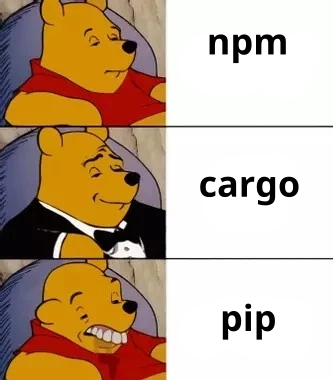this post was submitted on 13 Oct 2023
324 points (81.4% liked)
Programmer Humor
32479 readers
348 users here now
Post funny things about programming here! (Or just rant about your favourite programming language.)
Rules:
- Posts must be relevant to programming, programmers, or computer science.
- No NSFW content.
- Jokes must be in good taste. No hate speech, bigotry, etc.
founded 5 years ago
MODERATORS
you are viewing a single comment's thread
view the rest of the comments
view the rest of the comments

So you are saying that npm is better than pip?? I'm not saying pip is good, but npm?
npm has a lockfile which makes it infinitely better.
pip also has lock files
pip freeze > requirements.txtWould that just create a list of the current packages/versions without actually locking anything?
Yes, and all downstream dependencies
What do you mean? Nothing stops someone from manually installing an npm package that differs from package-lock.json - this behaves the same. If you
pip install -r requirements.txtit installs the exact versions specified by the package maintainer, just likenpm installthe only difference is python requires you to specify the "lock file" instead of implicitly reading one from the CWDAs I understand, when you update npm packages, if a package/version is specified in
package-lock.json, it will not get updated past that version. But running those pip commands you mentioned is only going to affect what version gets installed initially. From what I can tell, nothing about those commands is stopping pip from eventually updating a package past what you had specified in therequirements.txtthat you installed from.The behaviour you mention is from npm install, which will put the same exact version from the package-lock.json, if present. If not it will act as an npm update.
npm update will always update, and rewrite the package-lock.json file with the latest version available that complies with the restrictions defined on the package.json.
I may be wrong but, I think the difference may be that python only has the behaviour that package-lock.json offer, but not the package.json, which allows the developer to put constraints on which is the max/min version allowed to install.
If you want min-max behaviours you need to use wrappers like pipenv or jump into conda/mamba. Pip offers basic functionality because there are more advanced tools that the community uses for the more advanced use cases.
I don't follow. If my package-lock.json specifies package X v1.1 nothing stops me from manually telling npm to install package X v1.2, it will just update my package.json and package-lock.json afterwards
If a requirements.txt specifies X==1.1, pip will install v1.1, not 1.2 or a newer version. If I THEN install package Y that depends on X>1.1, the pip install output will say 1.1 is not compatible and that it is being upgraded to 1.2 to satisfy package Y's requirements. If package Y works fine on v1.1 and does not require the upgrade, it will leave package X at the version you had previously installed.